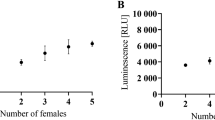Abstract
With increasing drug resistance in gastrointestinal parasites, identification of new anthelmintics is essential. The non-parasitic nematode Caenorhabditis elegans is used extensively as a model to identify drug targets and potential novel anthelmintics because it can be readily cultured in vitro. Traditionally, the assessment of worm viability has relied on labour-intensive developmental and behavioral assays. The 3-(4,5-dimethylthiazol-2-yl)-2,5-diphenyl tetrazolium bromide-formazan (MTT-formazan) colorimetric assay uses metabolic activity as a marker of viability in mammalian cell culture systems and has been applied for use with filarial nematodes. In the present study, this assay has been optimized and validated to rapidly assess the viability of C. elegans after drug treatment. Living, but not dead, C. elegans take up MTT and reduce it to the blue formazan, providing visual, qualitative, and quantitative assessment of viability. MTT at a concentration of 5 mg/ml with 3 h incubation was optimal for detecting changes in viability with drug treatment. We have applied this assay to quantitate the effects of ivermectin and short-chain alcohols on the viability of C. elegans. This assay is also applicable to first-stage larvae of the parasitic nematode Haemonchus contortus. The advantage of this assay is the rapid quantitation in screening drugs to identify potential anthelmintics.



Similar content being viewed by others
References
Anderson GL, Boyd WA, Williams PL (2001) Assessment of sublethal endpoints for toxicity testing with the nematode Caenorhabditis elegans. Environ Toxicol Chem 20:833–838
Anderson GL, Cole RD, Williams PL (2004) Assessing behavioural toxicity with Caenorhabditis elegans. Environ Toxicol Chem 23:1235–1240
Avery L, Horvitz HR (1990) Effects of starvation and neuroactive drugs on feeding in Caenorhabditis elegans. J Exp Zool 253:263–270
Boyd WA, Cole RD, Anderson GL, Williams PL (2003) The effects of metals and food availability on the behaviour of Caenorhabditis elegans. Environ Toxicol Chem 22:3049–3055
Brenner S (1974) The genetics of Caenorhabditis elegans. Genetics 77:71–94
Burglin TR, Lobos E, Blaxter ML (1998) Caenorhabditis elegans as a model for parasitic nematodes. Int J Parasitol 28:395–411
Comley JC, Townson S, Rees MJ, Dobinson A (1989a) The further application of MTT-formazan colorimetry to studies on filarial worm viability. Trop Med Parasitol 4:311–316
Comley JC, Rees MJ, Turner CH, Jenkins DC (1989b) Colorimetric quantitation of filarial viability. Int J Parasitol 19:77–83
Dengg M, van Meel JC (2004) Caenorhabditis elegans as a model system for rapid toxicity assessment of pharmaceutical compounds. J Pharmacol Toxicol Methods 50:209–214
Dias N, Nicolau A, Carvalho GS, Mota M, Lima N (1999) Miniaturization and application of the MTT assay to evaluate metabolic activity of protozoa in the presence of toxicants. J Basic Microbiol 39:103–108
Fujii M, Tanaka N, Miki K, Hossain MN, Endoh M, Ayusawa D (2005) Uncoupling of longevity and Paraquat resistance in mutants of the nematode Caenorhabditis elegans. Biosci Biotechnol Biochem 69:2015–2018
Geldhof P, Murray L, Couthier A, Gilleard JS, McLauchlan G, Knox DP, Britton C (2006) Testing the efficacy of RNA interference in Haemonchus contortus. Int J Parasitol 36:801–810
Gill MS, Olsen A, Sampayo JN, Lithgow GJ (2003) An automated high-throughput assay for survival of the nematode Caenorhabditis elegans. Free Radic Biol Med 35:558–565
Goldstein B, Takeshita H, Mizumoto K, Sawa H (2006) Wnt signals can function as positional cues in establishing cell polarity. Cell 10:391–396
Hope IA (1999) C. elegans: a practical approach. Oxford University, New York, NY, USA
Marks DC, Belov L, Davey MW, Davey RA, Kidman AD (1992) The MTT cell viability assay for cytotoxic testing in multidrug-resistant human leukemic cells. Leuk Res 12:1165–1173
Mosmann T (1983) Rapid colorimetric assay for cellular growth and survival: application to proliferation and cytotoxicity assays. J Immunol Methods 65:55–63
Nikolaou S, Hartman D, Presidente PJ, Newton SE, Gasser RB (2002) HcSTK, a Caenorhabditis elegans PAR-1 homologue from the parasitic nematode, Haemonchus contortus. Int J Parasitol 32:749–758
Rand JB, Johnson CD (1995) Genetic pharmacology: interactions between drugs and gene products in C. elegans. Methods Cell Biol 48:187–204
Simpkin KG, Coles GC (1981) The use of Caenorhabditis elegans for anthelmintic screening. J Chem Technol Biotechnol 31:66–69
Thompson G, de Pomerai DI (2005) Toxicity of short-chain alcohols to the nematode Caenorhabditis elegans: a comparison of endpoints. J Biochem Mol Toxicol 19:87–95
Ved R, Saha S, Westlund B, Perier C, Burnam L, Aluder A, Hoener M, Rodrigues CMP, Alfonso A, Steer C, Liu L, Przedborski S, Wolozin B (2005) Similar patterns of mitochondrial vulnerability and rescue induced by genetic modification of α-synuclein, Parkin and DJ-1 in Caenorhabditis elegans. J Biol Chem 52:42655–42668
Acknowledgment
Catherine James was kindly supported by an Australian Wool Innovation postgraduate scholarship. The authors would like to thank Prof. R. B Gasser for thoughtful discussions on this manuscript. All experiments involving animals were approved by the Animal Ethics Committee of the University of Sydney.
Author information
Authors and Affiliations
Corresponding author
Rights and permissions
About this article
Cite this article
James, C.E., Davey, M.W. A rapid colorimetric assay for the quantitation of the viability of free-living larvae of nematodes in vitro. Parasitol Res 101, 975–980 (2007). https://doi.org/10.1007/s00436-007-0572-1
Received:
Accepted:
Published:
Issue Date:
DOI: https://doi.org/10.1007/s00436-007-0572-1




